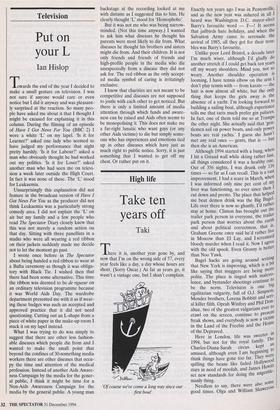Television
Put on your L
Ian Hislop
Towards the end of the year I decided to make a small gesture on television. I was not sure if anyone would care or even notice but I did it anyway and was pleasant- ly surprised at the reaction. So many peo- ple have asked me about it that I thought I might be excused for explaining it in this column. During the filming of an episode of Have I Got News For You (BBC 2) I wore a white 'L' on my lapel. 'Is it for Learner?' asked one lady who seemed to have judged my performance that night pretty harshly. 'Is it for Labour?' asked a man who obviously thought he had worked out my politics. 'Is it for Loser?' asked another man who had seen me on televi- sion a week later outside the High Court. In fact it was none of these. The 'L' stood for Leukaemia.
Unsurprisingly this explanation did not feature in the broadcast version of Have I Got News For You as the producer did not think Leukaemia was a particularly strong comedy area. I did not explain the 'L' on air but my family and a few people who read The Spectator Diary closely knew that this was not merely a random action on that day. Sitting with three panellists in a studio who were all wearing a red ribbon on their jackets suddenly made me decide not to let the moment go past.
I wrote once before in The Spectator about being handed a red ribbon to wear at a Bafta ceremony as though it was obliga- tory with Black Tie. I wished then that there had been some alternative. This time the ribbon was deemed to be de rigueur on an ordinary television programme because it was World Aids Day. The wardrobe department presented me with it as if wear- ing these badges was such an accepted and approved practice that it did not need questioning. Cutting out an L-shape from a piece of white paper in the make-up room I stuck it on my lapel instead.
What I was trying to do was simply to suggest that there are other less fashion- able diseases which people die from and I wanted to make the small point that beyond the confines of 30-something media workers there are other diseases that occu- py the time and attention of the medical profession. Instead of another Aids Aware- ness Campaign by the media for the gener- al public, h think it might be time for a Non-Aids Awareness Campaign for the media by the general public. A young man backstage at the recording looked at me with distaste as I suggested this to him. He clearly thought 1' stood for 'Homophobe'.
But it was not me who was being narrow- minded. (Not this time anyway.) I wanted to ask him what diseases he thought his parents were most likely to die from. What diseases he thought his brothers and sisters might die from. And their children. It is not only friends and friends of friends and high-profile people in the media who die unexpectedly from a disease they did not ask for. The red ribbon as the only accept- ed media symbol of caring is irritatingly exclusive.
I know that charities are not meant to be competitive and diseases are not supposed to jostle with each other to get noticed. But there is only a limited amount of media attention through which funds and aware- ness can be raised and Aids often seems to be monopolising it. This does not make me a far-right lunatic who want gays (or any other Aids victims) to die but simply some- one who has experiences and emotions tied up in other diseases which have just as much right to public notice. Sorry, it is just something that I wanted to get off my chest. Or rather put on it.


























































 Previous page
Previous page